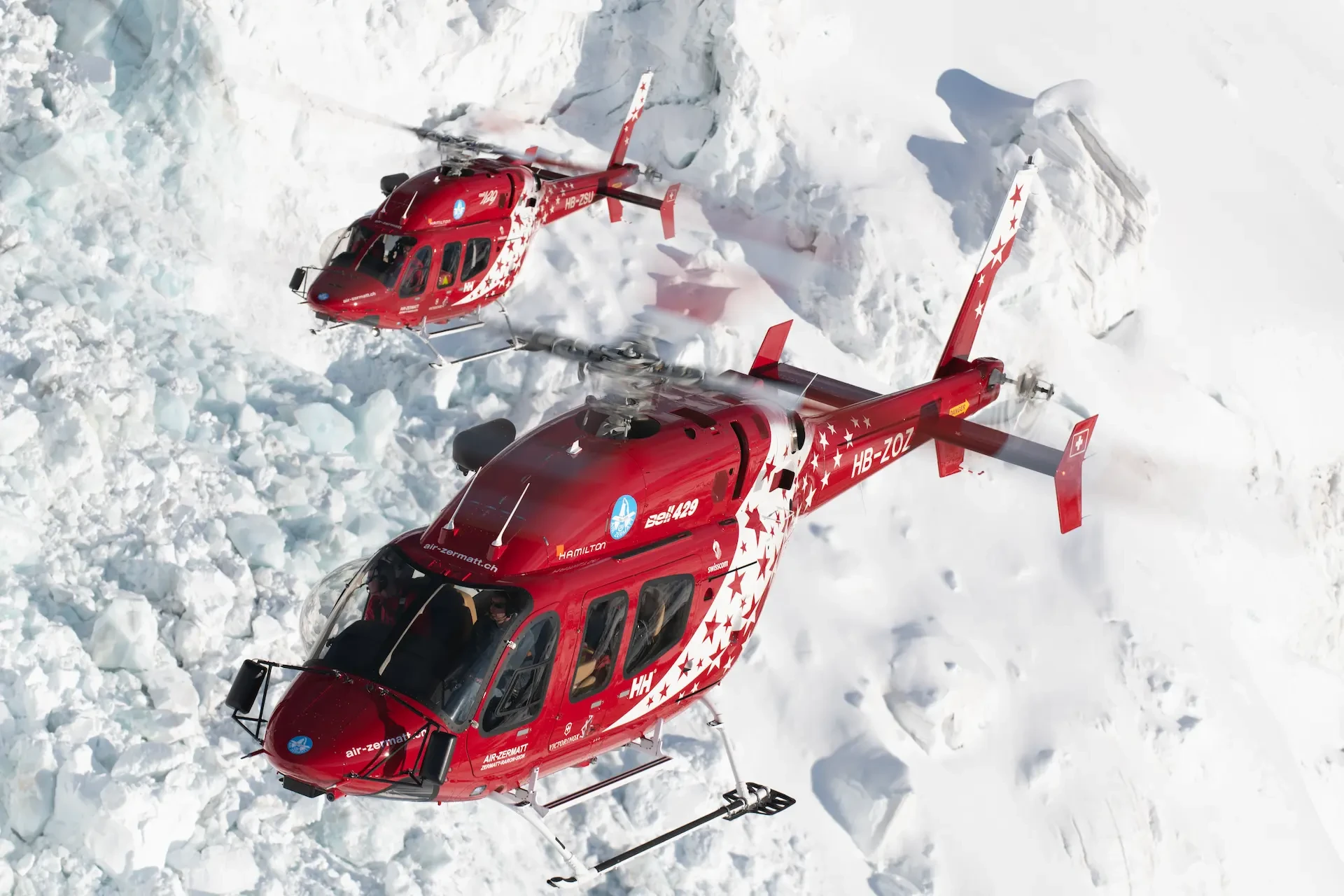Commencing with just a single helicopter, one pilot and a mechanic in 1968, Air Zermatt has grown to offer a wide range of helicopter flight and support services that includes tourism flights, a full range of utility and aerial work, a dedicated training center, HEMS and a ground ambulance service.
Air Zermatt is based in the Swiss village of Zermatt – situated under the Matterhorn - and employs around 75 people, operating eleven helicopters and three heliports around Switzerland. “With Air Zermatt, the HEMS operation is quite small compared to the rest of the company’s operations,” advised Dr Michael Scheiwein, a senior HEMS doctor with Air Zermatt. “The HEMS operation is widely covered by the media so is well known, but only two of the 11 helicopters are dedicated to HEMS work.” (two during the whole year and three during the winter season / additional helicopters will be provided in events like an avalanche rescue). According to Scheiwein, the company first entered the HEMS arena back in 1973. The early operation involved simple helicopter transport for patients, but Mann pushed for the inclusion of qualified medical personnel and the installation of proper medical equipment in the helicopters to provide more comprehensive medical care and rescue capability.
Fleet Development
The first HEMS aircraft were Alouette IIIs that were later replaced by EC135s, which served in the HEMS role for many years. More recently, the company transitioned to Bell 429s that are dedicated solely to HEMS and SAR work, with the first of two examples purchased in 2012. The two current 429s will be supplemented by a third example that will operate in a range of commercial services but be available as a spare aircraft to cover outages from defects or maintenance needs, and to operate as a third HEMS machine during the busiest seasonal periods around Christmas, New Year and Easter. “We always do search and rescue (SAR) with the HEMS helicopters and in areas where we can’t land, we can use the rescue hoist. The paramedic is the hoist operator in those cases, so as a doctor, we are on our own in regard to taking care of the patient,” Scheiwein explained. The normal HEMS crew is three, including pilot, doctor and paramedic but for extremely demanding locations such as glaciers and steep mountain faces, a mountain rescue specialist is added as a fourth crewmember and joins the doctor on the patient recovery, making the evolution significantly safer for all involved.
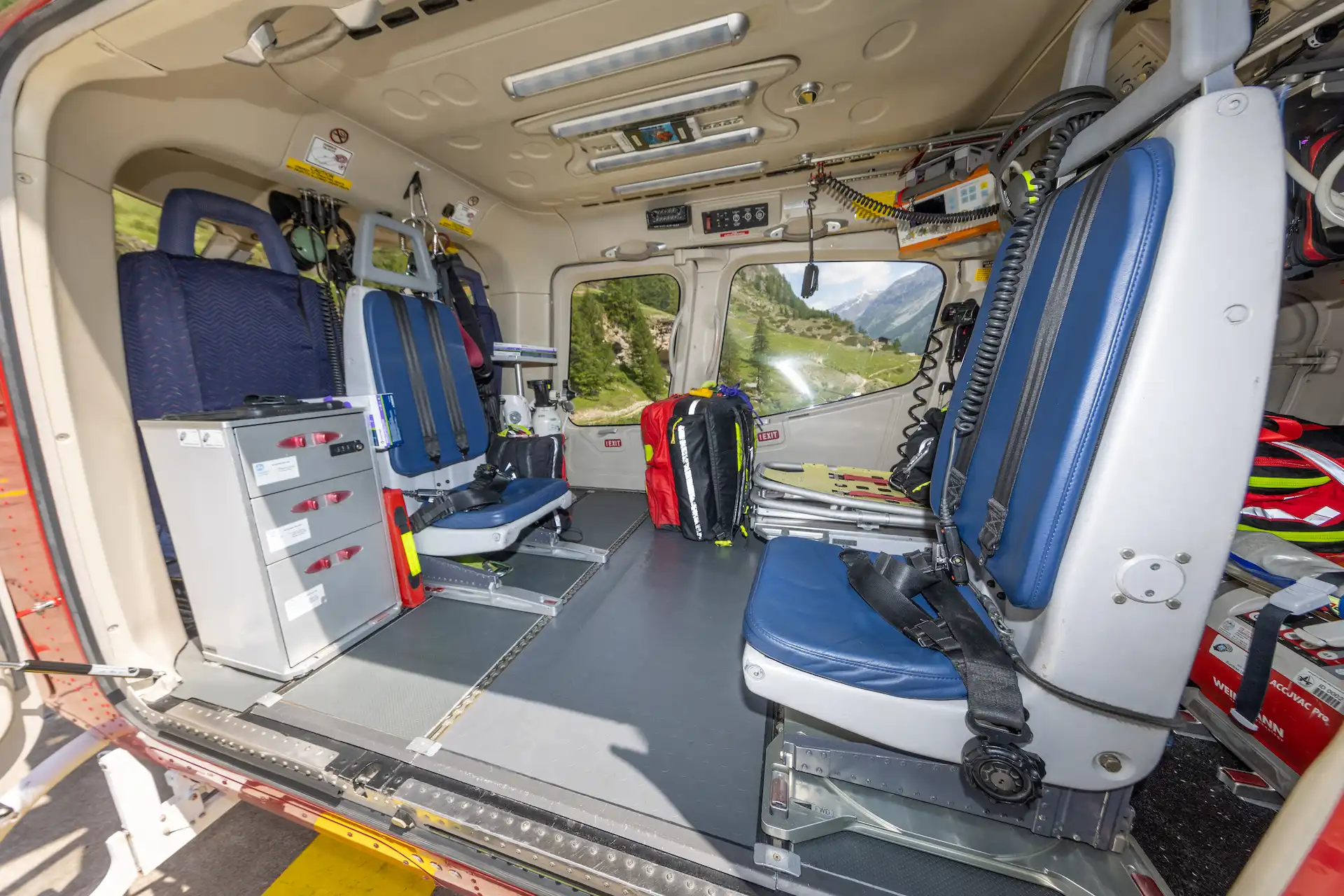
Scheiwein started with Air Zermatt in 2015 and he explained that although the paramedics are all employed by Air Zermatt and work full-time with the company, he and approximately thirty other doctors only work on HEMS with the company for around four to six single weeks throughout the year. For the rest of the time, they work in the hospitals to maintain their professional competence level. “You are trained very well and are treating patients every day in the hospital. If you only worked in HEMS there are a number of medical procedures that you wouldn’t do often enough to remain fully current and competent,” he noted. That total familiarity and competence is crucial, as the conditions encountered during HEMS operations make conducting such procedures much more difficult than in a controlled hospital environment. Difficult procedures sometimes have to be conducted during flight, particularly on longer journeys and Scheiwein observed that the extra size of the 429’s cabin provides a significant advantage in those circumstances. “In the H125 it’s just not possible and even in the H135 it is very tight,” he commented.
Because the 429s carry out the full range of SAR and HEMS missions, a comprehensive range of equipment and fittings is utilized. “In the morning we might have a call for a patient on the Matterhorn and then an hour later get a call for a hospital patient transfer. Anything is possible in this environment, so we have to take all the gear with us in all cases. While most people skiing or mountaineering are between twenty and sixty, we also have children on the ski-fields or there might be a child that has an accident in the village,” Air Zermatt’s first female paramedic Rebekka Frieden elaborated. Frieden has been a paramedic for ten years and joined the company in 2019, working part time on the ground ambulance and became full-time on the HEMS team in 2021. “It was always a dream of mine to combine my passion for mountaineering with my work as a paramedic,” she commented. “That’s why a couple of years ago I did my master’s degree in mountain emergency medicine up in Denali, Alaska.
Team Work
Pilots and paramedics go through recognized CRM training courses and although the doctors don’t, they undergo extensive training with Air Zermatt on helicopter operations and hoisting, along with advanced mountain and high-altitude medicine qualifications; critical because the effect of high altitude on patient physiology makes treatment more technically demanding. “We’ll often try to get the patient out of an incident area first and treat them in the helicopter, because of the risk of rockfalls and avalanches, unless they are in extreme pain from serious injuries, in which case we’ll give them something to mitigate the pain before we move them,” Scheiwein noted. “If we are on a hoist rescue but not in the high mountains, I will be on my own with the patient. If I have to intubate them in the deep snow on my own or carry out some other treatment that requires assistance, it is almost impossible and my only option is to put them in the rescue bag, get them onto the helicopter and treat them there.” Frieden added that newer doctors sometimes struggled with that scenario because their initial reaction is to immediately treat the patient and they forget to consider the additional risks posed by the high mountain environment.
If the helicopter is able to safely land at a scene, both doctor and paramedic will get out and the helicopter will leave the scene to eliminate risk from bystanders or passers-by. In all other cases, the paramedic will stay in the helicopter as they are responsible for safety in and around the aircraft. “People can be stupid,” opined Scheiwein. “There’s almost always a slope and if someone approaches from the higher ground, they may not recognize that there is a very real risk from the rotors.” Frieden and Scheiwein agree that the most important facet of CRM in the rear cabin is good communication between doctor and physician, something they feel is achieved at a high level on the Air Zermatt crews who all speak Swiss-German.
The aircraft are equipped with one Aerolite stretcher, complete with a rescue bag for the patient, and set up for use with the hoist. Medical equipment includes a respirator, ECG, ultrasound, defibrillator, Corpuls monitors and CPR device, infusion pumps and two syringe pumps for intensive care patients. Three large backpacks are carried, along with a small backpack that contains the most important equipment to treat severe trauma patients, for use in winter or when the equipment must be carried a significant distance. One large, heavy pack contains oxygen, and another contains specialist trauma equipment that is used less frequently, while a large ‘body-bag’ is carried for transporting deceased patients. Due to the topography, specialist rescue equipment is also carried and includes such items as a recovery ‘A-frame’ to lower rescue specialists into crevasses and the like, plus a power drill to cut away ice to enable recoveries from very tight locations. “The worst case is when they fall into a crevasse headfirst, as they usually get narrower as they get deeper and when someone is stuck head-down they very quickly start having trouble breathing,” Scheiwein added.
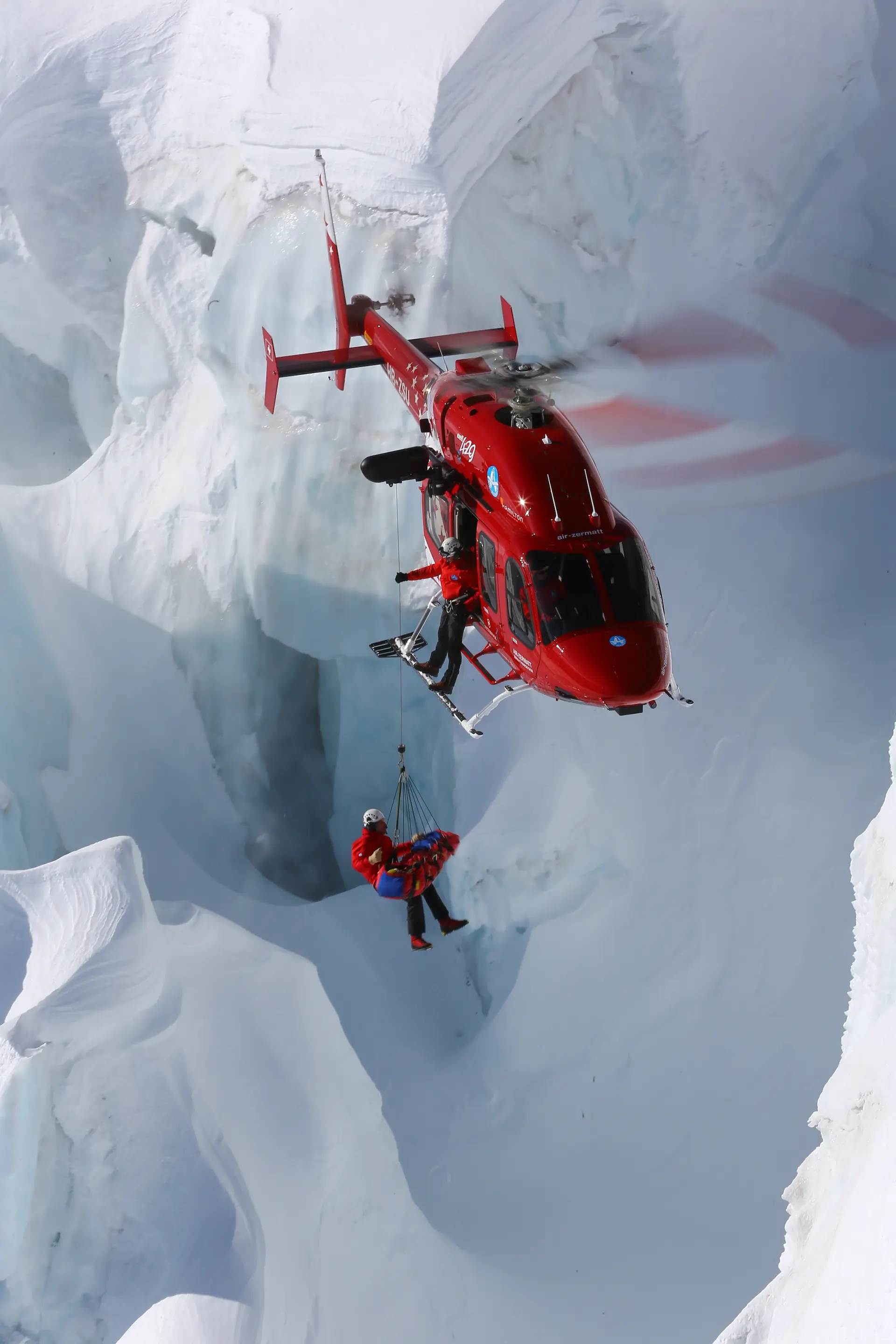
Area of Operations
Officially, Air Zermatt’s coverage area encompasses the whole eastern area of the Valais while Air Zermatt-owned Air-Glaciers in Gampel Sion provides additional coverage. As a result, almost the entire Valais with its large number of busy ski-fields and mountain resort locations is serviced. The area consists almost entirely of mountainous terrain and the HEMS machines also respond to traffic accidents within the Valais or EMS calls in the villages. In addition to its own coverage area, Air Zermatt can be called for Swiss nationals on the Italian side or for Italians in Switzerland, although those operations are under the control of the Italian HEMS operators. Conversely, Italian HEMS aircraft can be called to pick up a patient in Switzerland or deliver them to a Swiss medical facility. “There have also been times when the Italian helicopters are not flying at night, so we have flown into Italy cross border regions to carry out mountain recues during the hours of darkness. Sometimes that has really been interesting with some high mountain night rescues,” said Scheiwein.
The winter is by far the busiest period for the EMS machines and Scheiwein stated that it is not unusual to attend to 25 or 30 patients a day during that season, noting, “That is the reason we have three helicopters during the winter and each flies eight to ten patients per day. The two main helicopters operate 24 hours and the third machine is on day-duty only.” The crew at Gampel heliport lives on base during their duty period, on call 24hrs a day and has a dispatch timeframe of a few minutes, while the Zermatt-based crew is at the heliport from early morning to 6:00 p.m. and is on-call outside those hours. Scheiwein advised that the greatest proportion of winter injuries were skiing trauma accidents, from typical ski-field accidents to off-piste skiers getting lost, stuck, hurt or falling into crevasses. The resident population of Zermatt is around six or seven thousand people, but in the busy winter ski season that number rockets to approximately 40,000, which explains the huge variation in demand for the HEMS helicopters.
The EMS aircraft are equipped with a rescue hoist and Scheiwein estimated that it is required on approximately one in four callouts. All pilots and paramedics are fully trained in respectively flying for winch operations or operating the hoist and Scheiwein observed that the pilots also all fly the transport and utility missions, so are highly experienced in the precision flying required for longlining, sling work and hoisting. Unlike the day-only utility missions though, the HEMS work can often be carried out at night. This introduces the need for additional expertise and pilots fly with NVGs after taking off with the searchlight and a smaller hook-light and helmet lights provide illumination for the medical personnel, who call the heights to the pilot during hoisting. “It can be very difficult with minimal lighting and if I make a mistake with the height, it’s me who bears the consequences Scheiwein admitted.
Night Operations
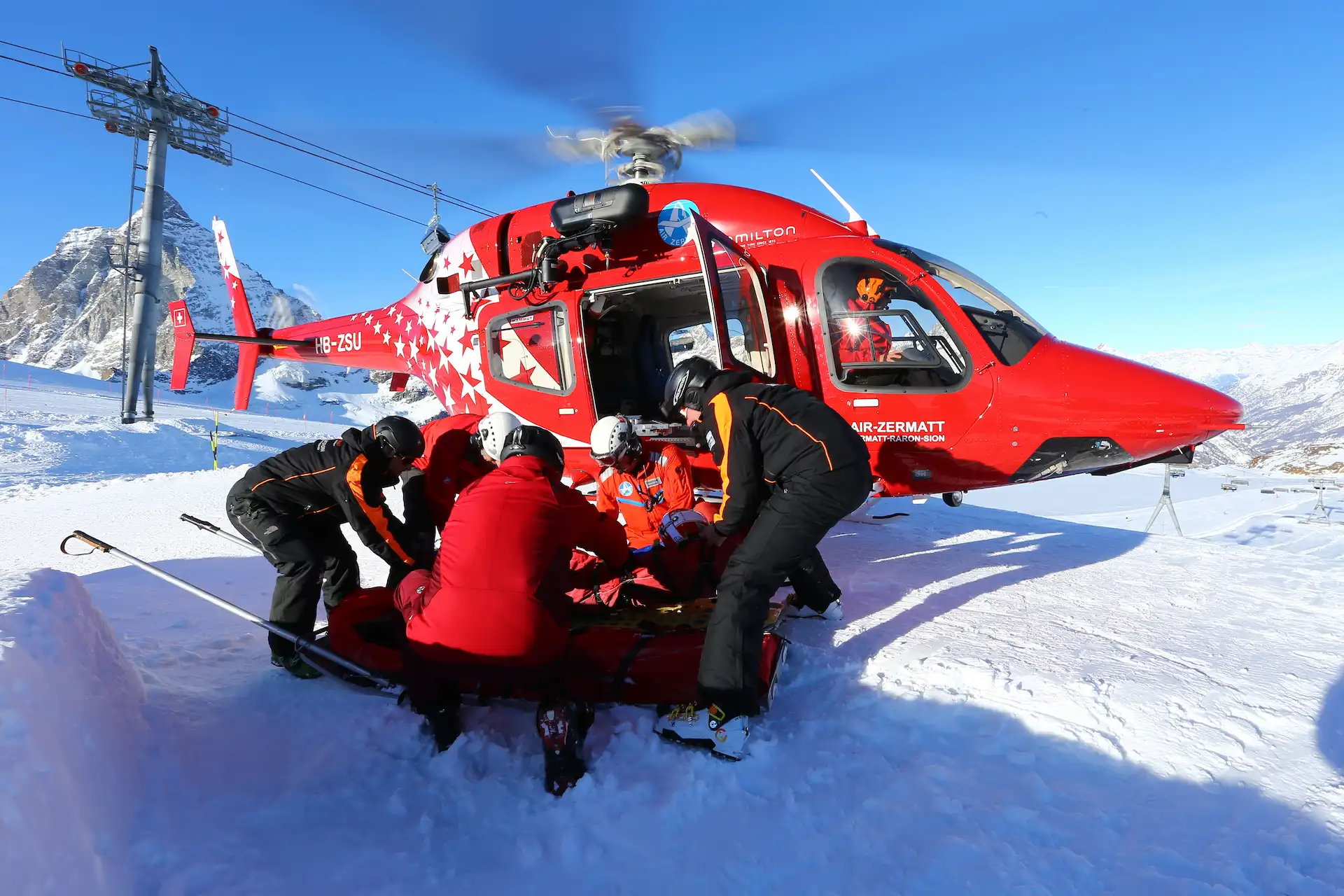
Because of the additional danger at night, night hoisting is only conducted when absolutely necessary. Hoist operator training for the paramedics is carried out over about nine months of service with Air Zermatt, after which they are competent to operate both day and night. If a scene landing is not feasible but the terrain permits, the doctor can step out of the hovering helicopter to attend the patient. The hoist is always used to recover the patient after treatment, however, as transferring a patient into a hovering machine is difficult, requiring extra manpower and introduces unnecessary and avoidable risk. The paramedics deploy on the HEC (human external cargo) line when necessary to recover patients in situations unsuited to hoisting or landing, and rescue specialists also have the capability to rappel from the HEC line on a 300ft rope, permitting the helicopter to maintain a higher altitude.
Summer Work
The second major season for HEMS is in summer from July to September, when the two primary aircraft work and each typically fly between four and eight patients per day. “Especially around the small Matterhorn we always have people walking around and falling into the crevasses, even though there are signs warning them not to, they do it anyway,” Scheiwein remarked. The most common summer injuries are suffered by mountain bikers and hikers, often relatively minor but sufficient to prevent the patient getting themselves off the mountain. The mountain huts are all open during the summer so it is not uncommon to be called out in the evening to attend medical emergencies at the huts; anything from injuries to heart attacks, altitude-induced sickness and neurological problems. “The rest of the year is a very quiet time and we will often only have much less missions and just the usual things like heart attacks, strokes and traffic accidents,” Scheiwein commented.
Patients with the common minor to moderate injuries and trauma are usually taken to the Valais’ Bezirk Visp hospital but it is not a level-1
trauma center, and Scheiwein explained that patients with more extreme injuries that require advanced trauma care – such as head injuries
with suspected internal bleeding, hip fractures or spinal fractures with accompanying neurological damage – are taken to the hospitals at
Sion or Bern, with their level-1 trauma capability. Aside from injured patients, Air Zermatt helicopters are sometimes required to rescue
stranded, uninjured climbers from the Matterhorn and because the altitude challenges the OGE hover performance of even the 429, Scheiwein
explained that an almost empty H125 is utilized, for its excellent high-altitude performance when carrying just the pilot and rescue
specialist, who recovers the stranded climber by longline. If the climber is injured, the 429 flies to an LZ at a suitable altitude, lands,
shuts down and waits for the H125 to deliver the patient to it for immediate treatment or transfer to a medical facility. “If there’s
someone in on the wall of the Matterhorn, you can’t do any medical treatment there anyway, so that’s why we just wait for them to bring the
patient to us,” Scheiwein adde
Mountain Challenge
Rescues in mountainous, forest-clad terrain can be problematic at times and Scheiwein recalled his most difficult rescue, a motor accident that was reported after a car’s automated crash report to the vehicle operator. “A Volvo car’s system sent a report that it had been involved in a crash and the driver was unresponsive, and the rescue center dispatched us to the coordinates,” he related, continuing, “It was late evening and when we got to the scene, the fire service and police were already there but could not find the vehicle. It was a very steep slope covered in thick forest and we searched with the light, eventually finding the car about a hundred meters down the mountain. We couldn’t land and couldn’t hoist because of powerlines around the site, so we had to land on the road and walk down through the forest, which was a very difficult process.” It transpired that the driver was very severely injured and trapped inside the vehicle, so he was initially treated inside the car. The fire service manhandled their recovery equipment down the steep slope and cut the driver from the wreckage and he had to be carried up the hill to the helicopter, with the fire service cutting logs and trees that were blocking the route. Scheiwein remembers that the entire mission, from takeoff to delivering the patient to hospital, took around three and a half hours, the longest-duration and most difficult mission he has undertaken to date.
Size Really Does Matter
Scheiwein cited the size of the 429’s cabin as a major advantage, along with the large windows and excellent external view, commenting, “The visibility lets us get a good look at the scene when we are approaching a rescue and when the patient is inside, it is so easy to work on them because the cabin is huge.” Even though Air Zermatt’s 429s have the lightweight interior, for very high-altitude missions as much medical equipment is removed as possible to reduce weight. “Sometimes even the doctor is dropped off at an altitude where the helicopter can safely hover, then they fly up, get the patient and then come back, especially in the warmer weather,” he advised. The helicopters do not require a heavy fuel load as almost all attended incidents are within ten to fifteen minutes flying time, the nearest hospital is a similar distance and the next closest major hospital is only thirty to forty minutes flight time away.
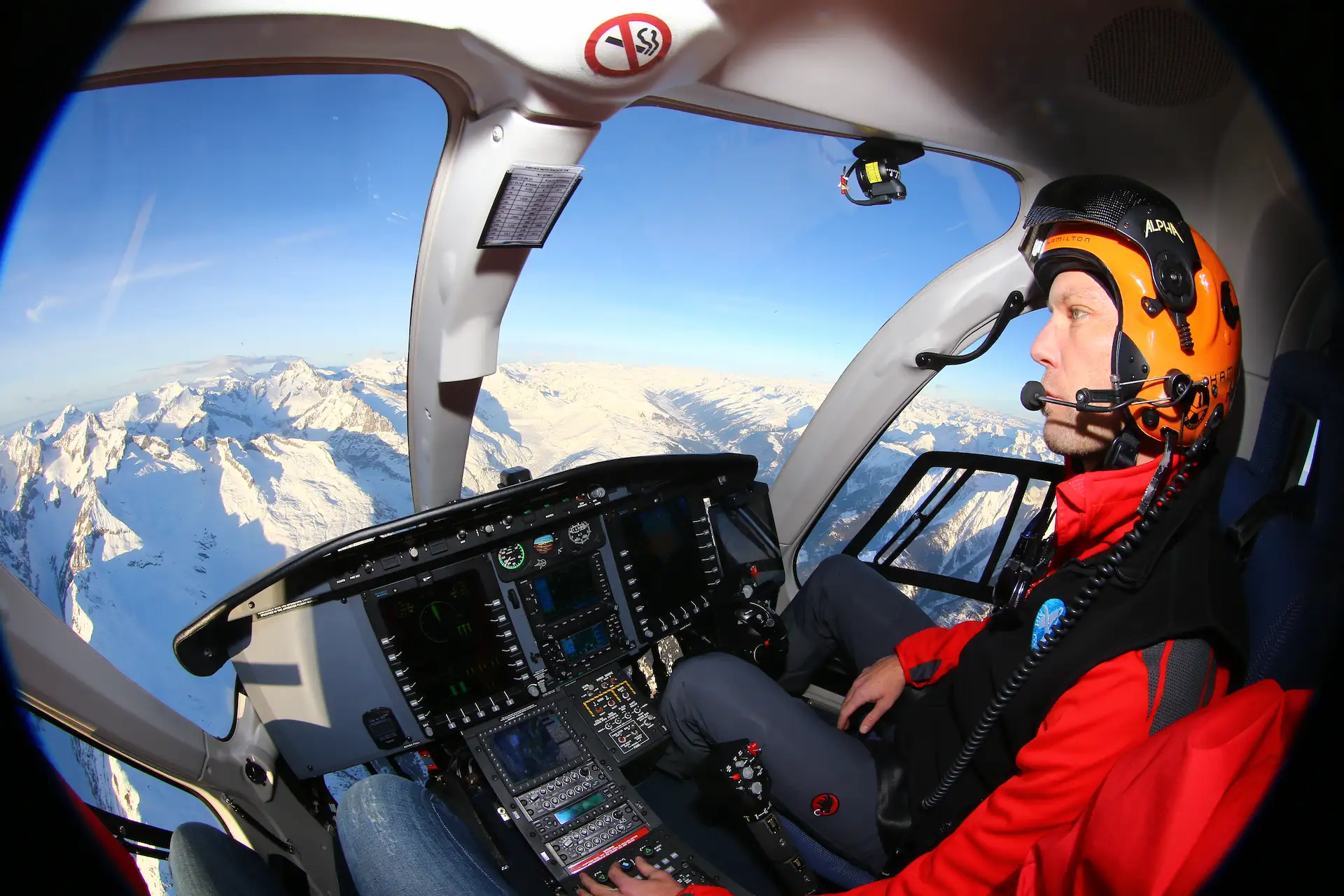
Pilot Simon Anthamatten has been flying the 429 for about a year and a half, and while he is enthusiastic about the aircraft, he noted that it is the first twin-turbine he has flown so he cannot compare it to other similar-size types. “From my point of view, the 429 is a pilot’s helicopter. I feel that some other types are so complex and sophisticated that they’re more like IFR aeroplanes. 429 is well suited to Swiss high-altitude operations but it is just as much at home doing utility work. Because it does a lot of sling work, we have a bubble window and a double cargo hook, so I could easily take the 429 now and transport a load of concrete or go to a 4,500-meter peak and do a rescue there,” he remarked. “It’s like the Air Zermatt pilots. We do a bit of everything but we’re all VFR only operations and we keep things as simple as possible.”
Anthamatten lives in the area and is well accustomed to the challenges of the high alpine terrain. Not only is he a pilot, but also a rescue specialist and keen mountaineer who has climbed the Matterhorn 140 times. He stressed that the primary goal of Air Zermatt HEMS missions is to recover patients from areas exposed to mountain dangers off the beaten track as fast as possible and deliver them to a hospital. Because of the wide range of incidents and missions that the 429s can be called upon to perform, ease of re-configuration is an important consideration. “It means we have to be able to adapt and so does the helicopter, so it’s crucial that it’s easy in or out with all this medical equipment,” he noted.
“When the doctor and paramedic work on a patient, you have to be in a place where you can work relaxed and focus 100 percent on the medical treatment. The most important thing is that there is no objective danger from the outside,” Anthamatten stated. “We call it a rendezvous system and a lot of times we go into the danger zone – the north face of the Matterhorn – pick the patient up with the HEC sling or the hoist and bring them to an LZ where the medical team can work accordingly. We are tailored to this area, these distances and these types of accidents, and these tactics have been developed over forty or fifty years. It’s important that we have all these capabilities available so we can adapt to the mission.” Illustrating his point, he advised that every few years a cable car becomes disabled with maybe 150 uninjured victims to recover from the gondolas. “If we used the hoist, we could only do two at once but with the HEC line we can carry up to six.”
Weather
Despite the sophistication and accuracy of modern weather forecasting, weather conditions can be a major factor in rescues, as Anthamatten explained. “On a rescue you’re always working in a micro-climate. Even on a really nice day the forest can generate a lot of updrafts and for me, that’s the worst thing for settling of power, for the vortex ring state. It can be a really tough situation on just a bike accident in the forest. Then you might be up near the top of the Matterhorn where it’s really windy. The good thing is, if you grew up and live here and are familiar with the alpine sports people do, then you understand the weather systems. Local knowledge is a real advantage but every incident is different and you have to evaluate every situation within the team.” He considers night rescue missions to be the most challenging aspect of the HEMS work and expressed much appreciation for the 429’s autopilot system that significantly reduces pilot workload and make such missions vastly safer and less stressful.
Anthamatten advised that during summer, missions high on the Matterhorn are the norm. “Just around Zermatt there are forty-two 4,000-meter peaks and we’d do maybe thirty or forty missions on the Matterhorn every year. Every second mission can be flown up to around 4,000-meters, and that’s why we only fuel to around thirty or forty percent capacity. I don’t think this helicopter has ever seen a full fuel load,” he commented. Around eighty percent of climbers have no guide, and it is not uncommon for ill-prepared or inexperienced mountaineers to call Air Zermatt in the dark early hours of the morning seeking rescue off the mountain, perhaps because of the cold. According to Anthamatten, he will try to ascertain the severity of their situation and sometimes advise them to simply wait for sunrise before calling back. “Often you’ll never hear from them again because the sun came up, they got warm again and decided to go on,” he said.
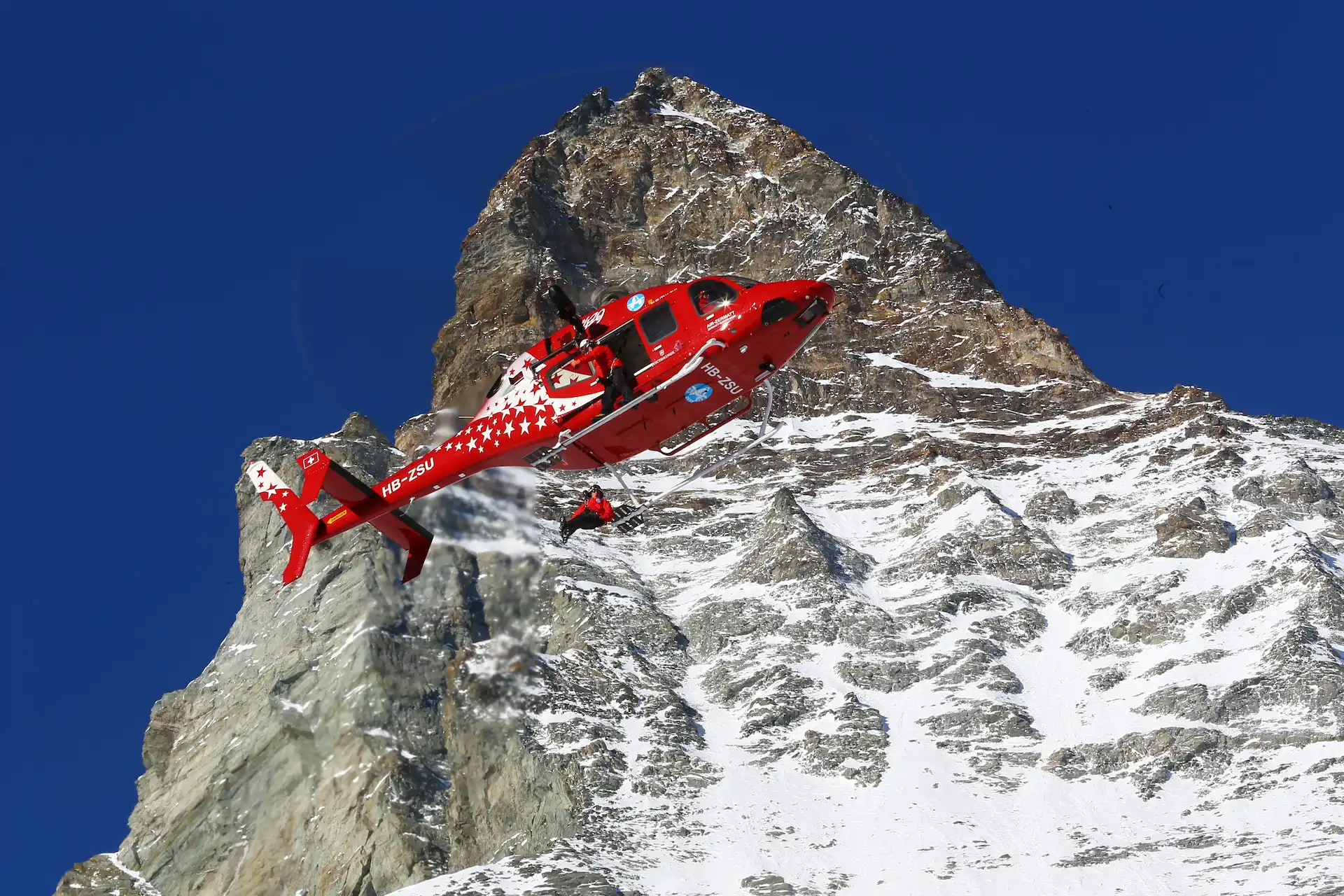
The location of the base at Zermatt means that the HEMS operation is extremely efficient. With the crews and village residents all living within minutes of the base, a flight can usually be commenced within minutes of a callout. “Even in cases where you need significant manpower, such as avalanches or crevasse falls, because we live here and know virtually everyone in town, we can call five rescue specialists and have them ready to go in a few minutes. That’s not because of the HEMS operator, it’s simply a result of the local geography and demographic,” opined Anthamatten. He also pointed out that wires and cables abound in the area so local knowledge boosts safety dramatically. For that reason, working on the full range of Air Zermatt’s mission types means that the pilots gain two or three times as many flying hours than they would if they were only flying HEMS.
With its modern, twin-turbine helicopters, experienced local crews, highly qualified medical personnel and HEMS systems developed over decades, Air Zermatt has become an integral part of the Zermatt and Swiss Alpine communities. Many, many hundreds of skiers, mountaineers, mountain bikers, hikers and community residents owe their lives to the company’s HEMS operation and many hundreds more will undoubtedly come to do so in years to come.
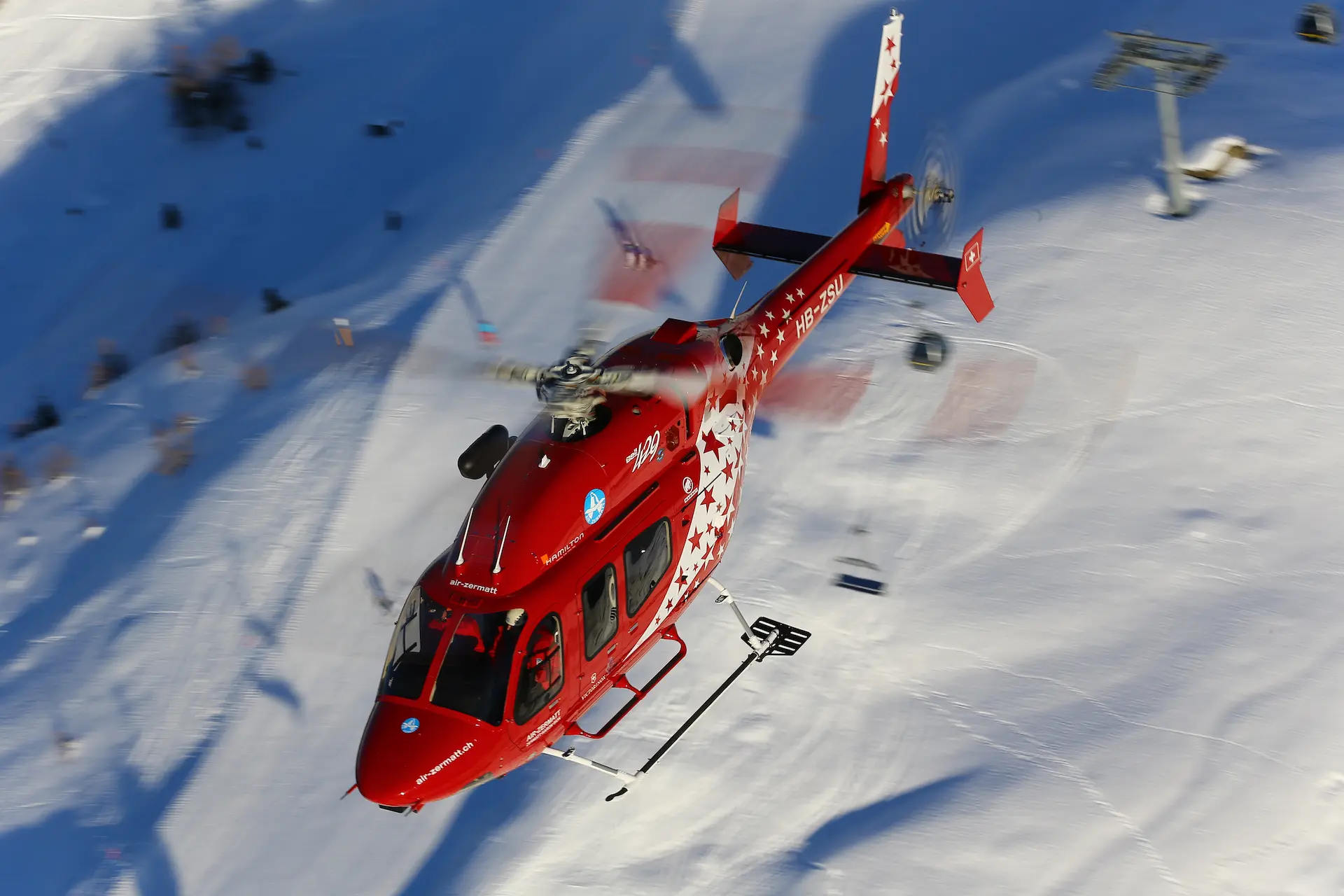
 HOME
HOME


